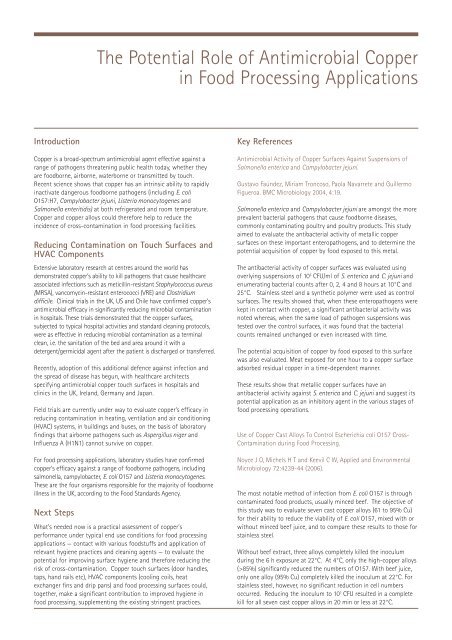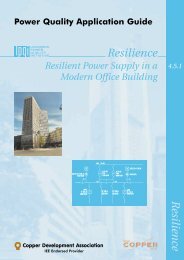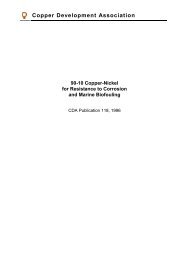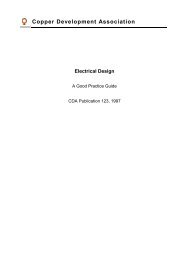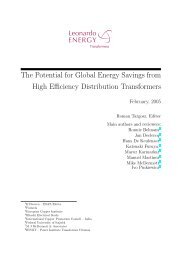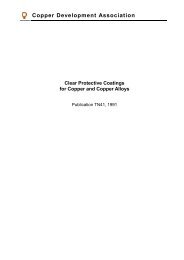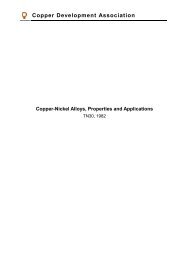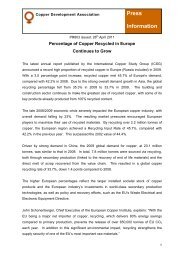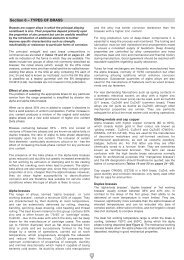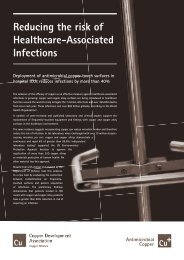The Potential Role of Antimicrobial Copper in Food Processing ...
The Potential Role of Antimicrobial Copper in Food Processing ...
The Potential Role of Antimicrobial Copper in Food Processing ...
You also want an ePaper? Increase the reach of your titles
YUMPU automatically turns print PDFs into web optimized ePapers that Google loves.
<strong>The</strong> <strong>Potential</strong> <strong>Role</strong> <strong>of</strong> <strong>Antimicrobial</strong> <strong>Copper</strong><strong>in</strong> <strong>Food</strong> Process<strong>in</strong>g ApplicationsIntroduction<strong>Copper</strong> is a broad-spectrum antimicrobial agent effective aga<strong>in</strong>st arange <strong>of</strong> pathogens threaten<strong>in</strong>g public health today, whether theyare foodborne, airborne, waterborne or transmitted by touch.Recent science shows that copper has an <strong>in</strong>tr<strong>in</strong>sic ability to rapidly<strong>in</strong>activate dangerous foodborne pathogens (<strong>in</strong>clud<strong>in</strong>g E. coliO157:H7, Campylobacter jejuni, Listeria monocytogenes andSalmonella enteritidis) at both refrigerated and room temperature.<strong>Copper</strong> and copper alloys could therefore help to reduce the<strong>in</strong>cidence <strong>of</strong> cross-contam<strong>in</strong>ation <strong>in</strong> food process<strong>in</strong>g facilities.Reduc<strong>in</strong>g Contam<strong>in</strong>ation on Touch Surfaces andHVAC ComponentsExtensive laboratory research at centres around the world hasdemonstrated copper’s ability to kill pathogens that cause healthcareassociated <strong>in</strong>fections such as meticill<strong>in</strong>-resistant Staphylococcus aureus(MRSA), vancomyc<strong>in</strong>-resistant enterococci (VRE) and Clostridiumdifficile. Cl<strong>in</strong>ical trials <strong>in</strong> the UK, US and Chile have confirmed copper’santimicrobial efficacy <strong>in</strong> significantly reduc<strong>in</strong>g microbial contam<strong>in</strong>ation<strong>in</strong> hospitals. <strong>The</strong>se trials demonstrated that the copper surfaces,subjected to typical hospital activities and standard clean<strong>in</strong>g protocols,were as effective <strong>in</strong> reduc<strong>in</strong>g microbial contam<strong>in</strong>ation as a term<strong>in</strong>alclean, i.e. the sanitation <strong>of</strong> the bed and area around it with adetergent/germicidal agent after the patient is discharged or transferred.Recently, adoption <strong>of</strong> this additional defence aga<strong>in</strong>st <strong>in</strong>fection andthe spread <strong>of</strong> disease has begun, with healthcare architectsspecify<strong>in</strong>g antimicrobial copper touch surfaces <strong>in</strong> hospitals andcl<strong>in</strong>ics <strong>in</strong> the UK, Ireland, Germany and Japan.Field trials are currently under way to evaluate copper’s efficacy <strong>in</strong>reduc<strong>in</strong>g contam<strong>in</strong>ation <strong>in</strong> heat<strong>in</strong>g, ventilation and air condition<strong>in</strong>g(HVAC) systems, <strong>in</strong> build<strong>in</strong>gs and buses, on the basis <strong>of</strong> laboratoryf<strong>in</strong>d<strong>in</strong>gs that airborne pathogens such as Aspergillus niger andInfluenza A (H1N1) cannot survive on copper.For food process<strong>in</strong>g applications, laboratory studies have confirmedcopper’s efficacy aga<strong>in</strong>st a range <strong>of</strong> foodborne pathogens, <strong>in</strong>clud<strong>in</strong>gsalmonella, campylobacter, E. coli O157 and Listeria monocytogenes.<strong>The</strong>se are the four organisms responsible for the majority <strong>of</strong> foodborneillness <strong>in</strong> the UK, accord<strong>in</strong>g to the <strong>Food</strong> Standards Agency.Next StepsWhat’s needed now is a practical assessment <strong>of</strong> copper’sperformance under typical end use conditions for food process<strong>in</strong>gapplications — contact with various foodstuffs and application <strong>of</strong>relevant hygiene practices and clean<strong>in</strong>g agents — to evaluate thepotential for improv<strong>in</strong>g surface hygiene and therefore reduc<strong>in</strong>g therisk <strong>of</strong> cross-contam<strong>in</strong>ation. <strong>Copper</strong> touch surfaces (door handles,taps, hand rails etc), HVAC components (cool<strong>in</strong>g coils, heatexchanger f<strong>in</strong>s and drip pans) and food process<strong>in</strong>g surfaces could,together, make a significant contribution to improved hygiene <strong>in</strong>food process<strong>in</strong>g, supplement<strong>in</strong>g the exist<strong>in</strong>g str<strong>in</strong>gent practices.Key References<strong>Antimicrobial</strong> Activity <strong>of</strong> <strong>Copper</strong> Surfaces Aga<strong>in</strong>st Suspensions <strong>of</strong>Salmonella enterica and Campylobacter jejuni.Gustavo Faúndez, Miriam Troncoso, Paola Navarrete and GuillermoFigueroa. BMC Microbiology 2004, 4:19.Salmonella enterica and Campylobacter jejuni are amongst the moreprevalent bacterial pathogens that cause foodborne diseases,commonly contam<strong>in</strong>at<strong>in</strong>g poultry and poultry products. This studyaimed to evaluate the antibacterial activity <strong>of</strong> metallic coppersurfaces on these important enteropathogens, and to determ<strong>in</strong>e thepotential acquisition <strong>of</strong> copper by food exposed to this metal.<strong>The</strong> antibacterial activity <strong>of</strong> copper surfaces was evaluated us<strong>in</strong>goverly<strong>in</strong>g suspensions <strong>of</strong> 10 6 CFU/ml <strong>of</strong> S. enterica and C. jejuni andenumerat<strong>in</strong>g bacterial counts after 0, 2, 4 and 8 hours at 10°C and25°C. Sta<strong>in</strong>less steel and a synthetic polymer were used as controlsurfaces. <strong>The</strong> results showed that, when these enteropathogens werekept <strong>in</strong> contact with copper, a significant antibacterial activity wasnoted whereas, when the same load <strong>of</strong> pathogen suspensions wastested over the control surfaces, it was found that the bacterialcounts rema<strong>in</strong>ed unchanged or even <strong>in</strong>creased with time.<strong>The</strong> potential acquisition <strong>of</strong> copper by food exposed to this surfacewas also evaluated. Meat exposed for one hour to a copper surfaceadsorbed residual copper <strong>in</strong> a time-dependent manner.<strong>The</strong>se results show that metallic copper surfaces have anantibacterial activity aga<strong>in</strong>st S. enterica and C. jejuni and suggest itspotential application as an <strong>in</strong>hibitory agent <strong>in</strong> the various stages <strong>of</strong>food process<strong>in</strong>g operations.Use <strong>of</strong> <strong>Copper</strong> Cast Alloys To Control Escherichia coli O157 Cross-Contam<strong>in</strong>ation dur<strong>in</strong>g <strong>Food</strong> Process<strong>in</strong>g.Noyce J O, Michels H T and Keevil C W, Applied and EnvironmentalMicrobiology 72:4239-44 (2006).<strong>The</strong> most notable method <strong>of</strong> <strong>in</strong>fection from E. coli O157 is throughcontam<strong>in</strong>ated food products, usually m<strong>in</strong>ced beef. <strong>The</strong> objective <strong>of</strong>this study was to evaluate seven cast copper alloys (61 to 95% Cu)for their ability to reduce the viability <strong>of</strong> E. coli O157, mixed with orwithout m<strong>in</strong>ced beef juice, and to compare these results to those forsta<strong>in</strong>less steel.Without beef extract, three alloys completely killed the <strong>in</strong>oculumdur<strong>in</strong>g the 6 h exposure at 22°C. At 4°C, only the high-copper alloys(>85%) significantly reduced the numbers <strong>of</strong> O157. With beef juice,only one alloy (95% Cu) completely killed the <strong>in</strong>oculum at 22°C. Forsta<strong>in</strong>less steel, however, no significant reduction <strong>in</strong> cell numbersoccurred. Reduc<strong>in</strong>g the <strong>in</strong>oculum to 10 3 CFU resulted <strong>in</strong> a completekill for all seven cast copper alloys <strong>in</strong> 20 m<strong>in</strong> or less at 22°C.
<strong>The</strong>se results clearly demonstrate the antimicrobial properties <strong>of</strong> castcopper alloys with regard to E. coli O157, and consequently thesealloys have the potential to aid <strong>in</strong> food safety.<strong>The</strong> results suggest that careful choice <strong>of</strong> surface material couldreduce the potential risk <strong>of</strong> cross-contam<strong>in</strong>ation <strong>in</strong> <strong>in</strong>dustrial,commercial and domestic environments.E. Coli viability on various surfaces at 20 o CCFU1.0E+101.0E+081.0E+06a) EDIC microscopy image <strong>of</strong> bacteria on copper after 90 m<strong>in</strong>utes <strong>in</strong>cubationb) EF microscopy image <strong>of</strong> bacteria sta<strong>in</strong>ed with CTC, after 90 m<strong>in</strong>utes<strong>in</strong>cubation. No bacteria were visible. This confirms that no bacteria survivedon the copper.1.0E+041.0E+021.0E+000 60 75 90 180 270 360Time (m<strong>in</strong>s)Pathogens that cause foodborne illness, such as E. coli, are quickly elim<strong>in</strong>ated fromcopper and copper alloy (e.g. brass, bronze) surfaces but survive for prolonged periodson plastic and sta<strong>in</strong>less steel surfaces.a) EDIC microscopy image <strong>of</strong> bacteria on sta<strong>in</strong>less steel after overnight<strong>in</strong>cubationb) EF microscopy image <strong>of</strong> bacteria sta<strong>in</strong>ed with CTC, after overnight <strong>in</strong>cubation.Respir<strong>in</strong>g (hence surviv<strong>in</strong>g and viable) bacteria were sta<strong>in</strong>ed bright red.Survival <strong>of</strong> Listeria monocytogenes Scott A on Metal Surfaces:Implications for Cross-contam<strong>in</strong>ation.Wilks S A, Michels H T, Keevil C W, Int J <strong>Food</strong> MicrobiolSep 1;111(2):93-8. Epub 2006 Jul 28.Listeria monocytogenes is an important re-emerg<strong>in</strong>g pathogenwhich is commonly found <strong>in</strong> the environment. Many outbreaks havebeen associated with the contam<strong>in</strong>ation <strong>of</strong> food produce, <strong>of</strong>tenl<strong>in</strong>ked to cross-contam<strong>in</strong>ation from surfaces or equipment used toprepare foodstuffs. In this study, a number <strong>of</strong> copper-base metalalloys were used to assess the survival times <strong>of</strong> L. monocytogeneson different materials, <strong>in</strong> comparison with sta<strong>in</strong>less steel, at roomtemperature. High concentrations (10 7 ) <strong>of</strong> bacteria were placed onmetal coupons cut from each alloy. After def<strong>in</strong>ed <strong>in</strong>cubation times,coupons were placed <strong>in</strong> tubes conta<strong>in</strong><strong>in</strong>g phosphate buffered sal<strong>in</strong>eand vortexed to remove the cells. Aliquots were then plated ontotryptone blood agar plates and the number <strong>of</strong> colony form<strong>in</strong>g unitscounted. <strong>The</strong> high concentration <strong>of</strong> bacteria was used to represent a‘worst-case’ scenario.<strong>The</strong> results <strong>in</strong>dicate that survival is greatly reduced on a copper-basealloy compared to sta<strong>in</strong>less steel. Viable cells could be detected onsta<strong>in</strong>less steel after 24 h <strong>in</strong>cubation at room temperature. On copper,brass, alum<strong>in</strong>ium bronze and silicon bronze, no viable bacteria couldbe detected after 60 m<strong>in</strong> <strong>in</strong>cubation, <strong>in</strong>dicat<strong>in</strong>g a 5-log reduction(the detection limit <strong>of</strong> the procedure was 100 bacteria).L. monocytogenes viability on copper alloy surfaces at 20 o CCFU1.00E+101.00E+081.00E+061.00E+041.00E+021.00E+000 15 30 45 60 75 90 Time (m<strong>in</strong>s)Number <strong>of</strong> bacteria surviv<strong>in</strong>g after various <strong>in</strong>cubation timeson different metal alloys at room temperature.Further InformationFurther scientific references and articles can be found atwww.copper<strong>in</strong>fo.co.uk/antimicrobial, where you will also f<strong>in</strong>d more<strong>in</strong>formation on the science and applications <strong>of</strong> antimicrobial copper.To register for email updates, jo<strong>in</strong> the <strong>Antimicrobial</strong> <strong>Copper</strong> InterestGroup by contact<strong>in</strong>g: bryony.samuel@copperdev.co.uk.<strong>Copper</strong> Development Association5 Grovelands Bus<strong>in</strong>ess CentreBoundary WayHemel Hempstead, HP2 7TEUKwww.copper<strong>in</strong>fo.co.ukhelpl<strong>in</strong>e@copperdev.co.ukwww.antimicrobialcopper.comPublication 204May 2010


